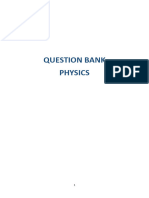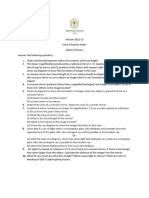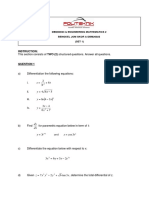Light Reflection & Refraction
Uploaded by
samta207Light Reflection & Refraction
Uploaded by
samta207Time - 70 mins.
SUCCESS INSTITUTE ( Light Reflection & Refraction ) MM - 50
Q1. A student uses a lens of focal length 40 cm and another of -20 cm. Write the nature and power of each lens. (2)
Q2. A convex lens forms a real and inverted image of a needle at a distance of 50 cm from it. Where is the needle
placed in front of the convex lens if the image is equal to the size of the object ? Also, find the power of the lens.
(2)
Q3. What is meant by power of a lens ? Write its formula and SI unit. (2)
Q4. Find the focal length of a lens of a power -2.0 D. What type of lens is this ? (1)
Q5. A 5 cm tall object is placed perpendicular to the principal axis of a convex lens of focal length 20 cm. The (5)
distance of the object from the lens is 30 cm. Find the position, nature and size of the image formed. Draw a
labelled ray diagram showing object distance, image distance and focal length in the above case.
Q6. An object 4.0 cm in size, is placed 25.0 cm in front of a concave mirror of focal length 15.0 cm . (5)
(i) At what distance from the mirror should a screen be placed in order to obtain a sharp image ?
(ii) Find the size of the image .
(iii) Draw a ray diagram to show the formation of image in this case .
Q7. If the image formed by a lens for all positions of an object placed in front of it is always erect and (3)
diminished, what is the nature of this lens ? Draw a ray diagram to justify your answer.
Q8. Draw a ray diagram to show the formation of image when the object is placed between optical centre and (2)
principal focus in convex lens .
Q9. Draw a ray diagram when the object is placed at 10 cm from the pole of a concave mirror of focal length 15 cm.
(2)
Q10. Light enters from air to glass having refractive index 1.50 What is the speed of light in the glass ? (1)
Q11. Explain the term 'absolute refractive index of a medium' and write an expression to relate it with the speed
of light in vacuum. (1)
Q12. State Snell's law of refraction. Write its mathematical form . (2)
Q13. When a ray of light travelling in air obliquely into a glass slab, it is observed that the light rays emerges (2)
parallel to the incident ray but it is shifted sideways slightly. Draw a ray diagram to illustrate it.
Q14. Define refraction of light. (1)
Q15. A real image of the size of an object is formed by a convex lens when the object is at a distance of
12 cm from it. Find the focal length of the lens. (3)
Q16. Find the position, nature and size of the image formed by a convex mirror of focal length 20 cm of an object
4 cm high placed at a distance of 30 cm from it. (3)
Q17. Give two uses of convex mirror . (1)
Q18. Give four uses of concave mirror . (1)
Q19. If the image formed by a spherical mirror for all positions of the object placed in front of it always erect and
diminished, what type of mirror is it ? Draw a labelled ray diagram to support your answer. (3)
Q20. Draw a labelled ray diagram to show the path of the reflected ray corresponding to an incident ray of (2)
light parallel to the principal axis of a convex mirror. Mark the angle of incidence and angle of reflection on it.
Q21. Define principal focus of a convex mirror. (1)
Q22. Refractive index of water and glass are and w.r.t. air or vaccum respectively. If the speed of light (3)
8
in glass is 2 x 10 m/s , find the speed of light in (i) air (ii) water.
Q23. Calculate the refractive index of the material of glass slab. Given that the speed of light through glass (2)
slab is 2 x m/s .
Science A4 size Page 1
You might also like
- Form One Integrated Science End of Year Exam75% (4)Form One Integrated Science End of Year Exam10 pages
- Ray Optics: Previous Years' Board Questions100% (1)Ray Optics: Previous Years' Board Questions5 pages
- Class 10 Chapter: Light - Reflection and Refraction Assignment 10.1100% (2)Class 10 Chapter: Light - Reflection and Refraction Assignment 10.17 pages
- Asian-School Light Reflection and Refraction Sample Paper 2019No ratings yetAsian-School Light Reflection and Refraction Sample Paper 20192 pages
- Class - X - Physics - Light Reflection and Refraction - Worksheet - 1No ratings yetClass - X - Physics - Light Reflection and Refraction - Worksheet - 14 pages
- 10th Question From Board Paper Light - PrintNo ratings yet10th Question From Board Paper Light - Print2 pages
- St. Teresa School: Holiday Homework Class-X Subject-Physics Chapter-10 (Light)No ratings yetSt. Teresa School: Holiday Homework Class-X Subject-Physics Chapter-10 (Light)4 pages
- Light - Reflection and Refraction Part 2No ratings yetLight - Reflection and Refraction Part 27 pages
- ISC Board Questions On Ray Optics Grade 12No ratings yetISC Board Questions On Ray Optics Grade 126 pages
- Class 10 Science Chapter 9 Previous Year Questions - Ray Optics - Light Reflection and Refraction Pyq[1]No ratings yetClass 10 Science Chapter 9 Previous Year Questions - Ray Optics - Light Reflection and Refraction Pyq[1]40 pages
- Worksheet-22 Reflection & Refraction of LightNo ratings yetWorksheet-22 Reflection & Refraction of Light2 pages
- X - Science - Physics - CH-9 Light - Assignment-3No ratings yetX - Science - Physics - CH-9 Light - Assignment-31 page
- _physics revision 12std -ray optics 11_2_2025 (1)No ratings yet_physics revision 12std -ray optics 11_2_2025 (1)6 pages
- 12 Ray Optics Assignment PDF.pdfdisplayName=12 Ray Optics Assignment PDFNo ratings yet12 Ray Optics Assignment PDF.pdfdisplayName=12 Ray Optics Assignment PDF3 pages
- 27 SVM Interview Questions (ANSWERED) To Master Before ML & Data Science Interview - MLStack - CafeNo ratings yet27 SVM Interview Questions (ANSWERED) To Master Before ML & Data Science Interview - MLStack - Cafe25 pages
- Effects of A Mycotoxins Binder On PlasmaNo ratings yetEffects of A Mycotoxins Binder On Plasma490 pages
- Land Water Resource Engineering Part 1 StudentNo ratings yetLand Water Resource Engineering Part 1 Student21 pages
- 6272 - Dr. D. Y. Patil Pratishthan's D.Y.Patil College of Engineering Akurdi, PuneNo ratings yet6272 - Dr. D. Y. Patil Pratishthan's D.Y.Patil College of Engineering Akurdi, Pune10 pages
- Managerial Accounting 16th Edition Garrison Solutions Manual - 2025 Version Is Available With All Chapters100% (7)Managerial Accounting 16th Edition Garrison Solutions Manual - 2025 Version Is Available With All Chapters55 pages
- Couple Therapy Disorganized Attachment DynamicsNo ratings yetCouple Therapy Disorganized Attachment Dynamics11 pages
- Course Syllabus: University of San CarlosNo ratings yetCourse Syllabus: University of San Carlos4 pages
- Kinetics of Polyethylene Terephthalate (PET) and Polystyrene (PS) Dynamic PyrolysisNo ratings yetKinetics of Polyethylene Terephthalate (PET) and Polystyrene (PS) Dynamic Pyrolysis9 pages

























































































